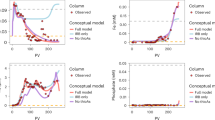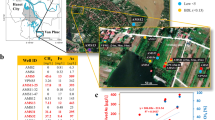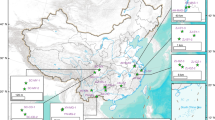Abstract
Microbes play a prominent role in transforming arsenic to and from immobile forms in aquifers1. Much of this cycling involves inorganic forms of arsenic2, but microbes can also generate organic forms through methylation3, although this process is often considered insignificant in aquifers4,5,6,7. Here we identify the presence of dimethylarsinate and other methylated arsenic species in an aquifer hosted in volcaniclastic sedimentary rocks. We find that dimethylarsinate is widespread in the aquifer and its concentration correlates strongly with arsenite concentration. We use laboratory incubation experiments and an aquifer injection test to show that aquifer microbes can produce dimethylarsinate at rates of about 0.1% of total dissolved arsenic per day, comparable to rates of dimethylarsinate production in surface environments. Based on these results, we estimate that globally, biomethylation in aquifers has the potential to transform 100 tons of inorganic arsenic to methylated arsenic species per year, compared with the 420–1,250 tons of inorganic arsenic that undergoes biomethylation in soils8. We therefore conclude that biomethylation could contribute significantly to aquifer arsenic cycling. Because biomethylation yields arsine and methylarsines, which are more volatile and prone to diffusion than other arsenic species, we further suggest that biomethylation may serve as a link between surface and subsurface arsenic cycling.
This is a preview of subscription content, access via your institution
Access options
Subscribe to this journal
Receive 12 print issues and online access
$259.00 per year
only $21.58 per issue
Buy this article
- Purchase on Springer Link
- Instant access to full article PDF
Prices may be subject to local taxes which are calculated during checkout



Similar content being viewed by others
References
Mukhopadhyay, R., Rosen, B. P., Phung, L. T. & Silver, S. Microbial arsenic: From geocycles to genes and enzymes. FEMS Microbiol. Rev. 26, 311–325 (2002).
Zhu, Y-G., Yoshinaga, M., Zhao, F-J. & Rosen, B. P. Earth abides arsenic biotransformations. Annu. Rev. Earth Planet Sci. 42, 443–467 (2014).
Bentley, R. & Chasteen, T. G. Microbial methylation of metalloids: Arsenic, antimony, and bismuth. Microbiol. Mol. Biol. Rev. 66, 250–271 (2002).
Lloyd, J. R. in Biological Chemistry of Arsenic, Antimony and Bismuth (ed. Sun, H.) Ch. 6, 135–143 (Wiley, 2010).
Oremland, R. S. & Stolz, J. F. The ecology of arsenic. Science 300, 939–944 (2003).
Rhine, E. D., Garcia-Dominguez, E., Phelps, C. D. & Young, L. Y. Environmental microbes can speciate and cycle arsenic. Environ. Sci. Technol. 39, 9569–9573 (2005).
Lièvremont, D., Bertin, P. N. & Lett, M-C. Arsenic in contaminated waters: Biogeochemical cycle, microbial metabolism and biotreatment processes. Biochimie 91, 1229–1237 (2009).
Mestrot, A. et al. Field fluxes and speciation of arsines emanating from soils. Environ. Sci. Technol. 45, 1798–1804 (2011).
Islam, F. S. et al. Role of metal-reducing bacteria in arsenic release from Bengal delta sediments. Nature 430, 68–71 (2004).
Qin, J. et al. Arsenic detoxification and evolution of trimethylarsine gas by a microbial arsenite S-adenosylmethionine methyltransferase. Proc. Natl Acad. Sci. USA 103, 2075–2080 (2006).
Wood, J. M. Biological cycles for toxic elements in the environment. Science 183, 1049–1052 (1974).
Gault, A. G. et al. in Plasma Source Mass Spectrometry: Applications and Emerging Technologies (eds Holland, G. & Tanner, S. D.) 112–126 (Royal Society of Chemistry, 2003).
Shraim, A., Sekaran, N. C., Anuradha, C. D. & Hirano, S. Speciation of arsenic in tube-well water samples collected from West Bengal, India, by high-performance liquid chromatography–inductively coupled plasma mass spectrometry. Appl. Organomet. Chem. 16, 202–209 (2002).
Xie, X. et al. Geochemistry of redox-sensitive elements and sulfur isotopes in the high arsenic groundwater system of Datong Basin, China. Sci. Total Environ. 407, 3823–3835 (2009).
Lin, N-F., Tang, J. & Bian, J-M. Characteristics of environmental geochemistry in the arseniasis area of the Inner Mongolia of China. Environ. Geochem. Health 24, 249–259 (2002).
Lin, T-H., Huang, Y-L. & Ming-Yuh, W. Arsenic species in drinking water, hair, fingernails, and urine of patients with blackfoot disease. J. Toxicol. Environ. Health A 53, 85–93 (1998).
Christodoulidou, M. et al. Arsenic concentrations in groundwaters of Cyprus. J. Hydrol. 468–469, 94–100 (2012).
Watts, M. J., O’Reilly, J., Marcilla, A. L., Shaw, R. A. & Ward, N. I. Field based speciation of arsenic in UK and Argentinean water samples. Environ. Geochem. Health 32, 479–490 (2010).
Del Razo, L. M., Arellano, M. A. & Cebrián, M. E. The oxidation states of arsenic in well-water from a chronic arsenicism area of Northern Mexico. Environ. Pollut. 64, 143–153 (1990).
Braman, R. S. & Foreback, C. C. Methylated forms of arsenic in the environment. Science 182, 1247–1249 (1973).
Serfes, M. E., Spayd, S. E. & Herman, G. C. in Advances in Arsenic Research Vol. 915 (eds O’day, P. A., Vlassopoulos, D., Meng, X. & Benning, L. G.) Ch. 13, 175–190 (ACS Symposium Series, American Chemical Society, 2005).
Gannett, M. W. & Caldwell, R. R. Geologic Framework of the Willamette Lowland Aquifer System, Oregon and Washington (US Geological Survey, 1998).
Istok, J. D., Humphrey, M. D., Schroth, M. H., Hyman, M. R. & O’Reilly, K. T. Single-well, ‘push-pull’ test for in situ determination of microbial activities. Ground Water 35, 619–631 (1997).
Lafferty, B. J. & Loeppert, R. H. Methyl arsenic adsorption and desorption behavior on iron oxides. Environ. Sci. Technol. 39, 2120–2127 (2005).
Aurilio, A. C., Mason, R. P. & Hemond, H. F. Speciation and fate of arsenic in three lakes of the Aberjona Watershed. Environ. Sci. Technol. 28, 577–585 (1994).
Sohrin, Y., Matsui, M., Kawashima, M., Hojo, M. & Hasegawa, H. Arsenic biogeochemistry affected by eutrophication in Lake Biwa, Japan. Environ. Sci. Technol. 31, 2712–2720 (1997).
Smedley, P. L. & Kinniburgh, D. G. A review of the source, behaviour and distribution of arsenic in natural waters. Appl. Geochem. 17, 517–568 (2002).
Koide, H. et al. Subterranean containment and long-term storage of carbon dioxide in unused aquifers and in depleted natural gas reservoirs. Energy Convers. Manage. 33, 619–626 (1992).
Chilvers, D. & Peterson, P. in Lead, Mercury, Cadmium and Arsenic in the Environment (eds Hutchinson, T. C. & Meema, K. M.) Ch. 17, 279–301 (Wiley, 1987).
Akter, K. F., Owens, G., Davey, D. E. & Naidu, R. Arsenic speciation and toxicity in biological systems. Rev. Environ. Contam. Toxicol. 184, 97–149 (2005).
Acknowledgements
We thank the well owners for access permission, H. Jin for help with field sampling and J. Istok for assistance in the aquifer test. This research was supported by the US National Science Foundation (grant 0810190 to Q.J.).
Author information
Authors and Affiliations
Contributions
Q.J. and S.R.H. designed the project. Q.J. compiled previous studies of groundwater methylarsenicals. Q.J. and M.F.K. conducted the field sampling and analysis. S.C.M. carried out the laboratory experiments. Q.J. and A.R.D. carried out the aquifer test. Q.J. wrote the manuscript, with significant input from S.R.H. and M.F.K.
Corresponding author
Ethics declarations
Competing interests
The authors declare no competing financial interests.
Supplementary information
Supplementary Information
Supplementary Information (PDF 5782 kb)
Rights and permissions
About this article
Cite this article
Maguffin, S., Kirk, M., Daigle, A. et al. Substantial contribution of biomethylation to aquifer arsenic cycling. Nature Geosci 8, 290–293 (2015). https://doi.org/10.1038/ngeo2383
Received:
Accepted:
Published:
Issue Date:
DOI: https://doi.org/10.1038/ngeo2383
This article is cited by
-
Occurrence, Geochemistry and Speciation of Elevated Arsenic Concentrations in a Fractured Bedrock Aquifer System
Archives of Environmental Contamination and Toxicology (2021)
-
Unique diversity and functions of the arsenic-methylating microorganisms from the tailings of Shimen Realgar Mine
Ecotoxicology (2020)
-
Arsenic mobilization in a high arsenic groundwater revealed by metagenomic and Geochip analyses
Scientific Reports (2019)
-
Diversity and abundance of arsenic methylating microorganisms in high arsenic groundwater from Hetao Plain of Inner Mongolia, China
Ecotoxicology (2018)
-
Microbial mediated arsenic biotransformation in wetlands
Frontiers of Environmental Science & Engineering (2017)



